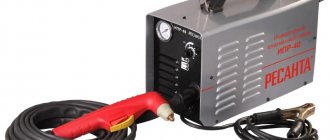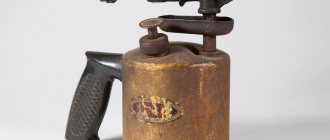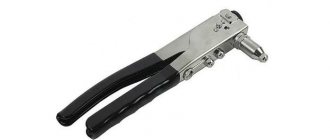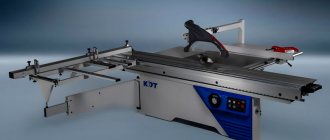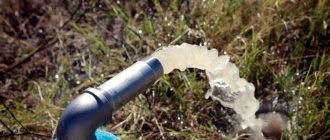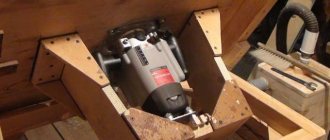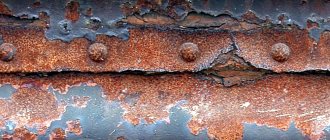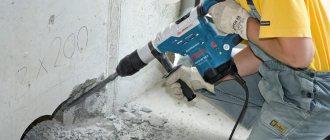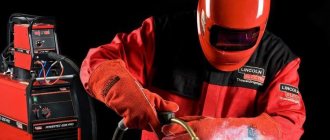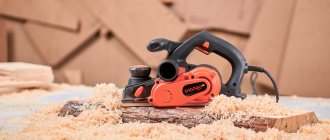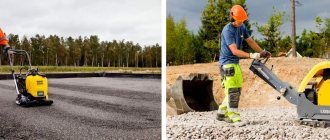A compact device consisting of a prefabricated structure consisting of a fan, a heating element, a common housing and a nozzle. Power supply from a single-phase electrical network 220 volts. Most often, a soldering gun works as part of a station, together with a control unit. The thermal block is used for local heating of the soldering area, melting materials with a low melting point: plastics, polymers, tin, lead, bismuth and alloys based on fusible metals. The maximum airflow can reach 400~600°C. Selection criteria: outlet air temperature, flow rate, mass flow.
ELEMENT 858D – inexpensive
Hand tool with almost instant warm-up. The device reaches operating temperature in less than one second. It is possible to change the thermal range. Works with various types of microcircuit cases, preheating the contacts to the required temperature.
Easily melts plastic and polymers. Melts alloys based on low-melting metals. It has a constant heated thermal air flow with adjustable mass flow.
Pros:
- Compact, light weight.
- Comfortable handle made of pleasant material, clear and easy adjustment.
- Cost, complete with attachments.
Minuses:
- Thermal protection against overheating would be useful.
Recommendations: 11 Best Soldering Irons
12 best machines for welding polypropylene pipes
15 best welding machines
Soldering stations
To perform high-quality repairs, professional equipment is required. The trading network and AliExpress platform provide a wide selection of various devices. The operation of complex electronic devices is carried out only with the help of a special soldering station.
Nowadays there is a huge selection of products, but before purchasing them, experts recommend understanding their types, purposes, and capabilities.
Contact
The station looks like a soldering iron equipped with an electronic temperature controller. Soldering devices are categorized by solder:
- tin-lead;
- lead-free solders. A heater with a power (up to 160 watts) and a high melting point is built into such a device. With a temperature regulator it is easier to solder low-melting solder with lead.
Analogue, digital, induction
The separation of types of soldering equipment is influenced by the operating principle of the control unit.
- Analog.
The temperature is stabilized provided that the heater operates until the tip warms up to certain temperatures, then the power automatically turns off.
When the temperature drops to a certain level, the heater turns on and heats the core again. The operation of the device is monitored by an electromagnetic relay; it is controlled using electronics and a temperature sensor.
The equipment is relatively inexpensive, but is characterized by low accuracy, at which the tip overheats and, as a result, the core changes.
- Digital.
Soldering is done using a heater. The process is controlled by the PID controller by a program embedded in the microcontroller. Digital control is considered more accurate.
- Induction.
This station heats the tip due to a pulse coil that operates with high-frequency oscillations that generate eddy current in ferromagnetic coatings. The tip warms up to a certain temperature (Curie point), then when the magnetic properties change, the heating ends.
BAKU BK-8032A++ – with microprocessor
Soldering gun with built-in microprocessor-based remote control. The electronic system allows you to regulate the degree of heating, increase or decrease the mass air flow. There is a function to return to the original parameters.
The displayed data is visualized on a digital display. The heating element is made in the form of a spiral. Turbine type air blower. Power supply – single-phase stationary electrical network 220 volts. Air flow range 0~30L/min. Heating the gas-air mixture to 480°C.
Pros:
- Compact lightweight hot air gun.
- Fast and efficient heating.
- Price, clear and simple controls.
Minuses:
- During prolonged operation at peak temperatures, the handle becomes noticeably warm.
Criterias of choice
The soldering device ensures the assembly of parts. The quality of work depends on the following parameters:
- Type of heater. Modern soldering stations have heating elements made of ceramics and nichrome. Ceramics heats up instantly, but it is quite sensitive to uneven heating and cracks quickly. To ensure the ceramic heater has good heat transfer, long-term operation, and high power, a thermal stabilizer is used. The nichrome element wears out very quickly; it is used for one-time use. But due to the very low cost, there is rationality in purchasing it.
- Intervals in temperature regulation.
- Warm-up speed.
- Power for high-quality operation of the device. It is necessary for soldering a tablet, navigator, or smartphone.
- Voltage.
- Ergonomic parameters: shape, dimensions, weight.
- Temperature for soldering (should not be lower than 250C).
For any device it is necessary to have several replaceable cores of different sizes, edges, and shapes. They influence the final result:
- a large area increases heat transfer during soldering;
- Soldering of some parts depends on the shape of the core and temperature.
When choosing equipment for installation, you need to figure out whether this device has the ability to replace failed parts.
BISON 55350 – inexpensive professional
Professional grade hot air soldering gun. Used for dismantling electronic radio elements or soldering using a non-contact method. Heating of the air flow to a temperature of 500°C occurs in a fraction of a second.
Localization of the heating site is carried out by three replaceable nozzles with different diameters of the outlet nozzle. An economical standby mode is provided for temporary breaks in work. The device is distinguished by the ability to adjust the mass air flow, reaching a maximum of 120 l/min.
Pros:
- Lightweight, easy to use. Ergonomic handle with anti-slip coating.
- Decent mass air flow, smooth adjustment possible.
- Price, electronic control, display.
Minuses:
- There are no negative reviews.
Self-assembly
If it is not possible to purchase a soldering gun because the price is too high, then you can quickly make one with your own hands from scrap materials.
Read also: How to make an emery tool with your own hands
A homemade hairdryer, provided that high-quality components are used and assembly technology is followed, will allow you to perform all the necessary tasks for its intended purpose.
Before you start assembling it yourself, you need to prepare the material, as well as make a rough diagram of the soldering device. You can make a stationary and portable homemade hair dryer with your own hands.
A stationary device cannot be moved if necessary, and the operating temperature will not affect the handle of the device in any way.
In this case, a nichrome wire should be used as a heating element, which should be correctly laid on a cylindrical surface.
The base itself can be taken from a faulty hair dryer. The blower element can be any small fan, for example from an aquarium compressor.
You should also definitely consider the trigger mechanism, as well as the temperature regulator.
When doing the assembly yourself, after winding the spiral onto a special tube, it is recommended to tightly wind the fiberglass over it. Next, you should make a thermal insulating tube and put it on the spiral.
This nozzle will protect the housing structure from overheating, even if the operating temperature of the air flow is higher than normal. To force air flow, it is necessary to make and install the blower element itself.
It is best to install it in the back of the hair dryer body. The wire from the heater must be passed through a rheostat, which will allow you to control the heating mode.
The nozzle should be cylindrical and attached in front of the heating element. It is the nozzle that will provide the necessary direction of hot air flows.
A start button is also mounted in a convenient place; if desired, you can equip a homemade hair dryer designed for various soldering with additional lighting, which will allow you to perform the work not only conveniently, but also with higher accuracy.
Assembling a hair dryer intended for soldering exclusively with your own hands is not difficult if you wish.
This device will allow the home handyman to perform a variety of repair work around the house.
Almost all the necessary elements and materials for its self-assembly can be found in the pantry. This will allow you to avoid unnecessary costs for purchasing a factory device, the price of which may unpleasantly surprise you.
A properly assembled hair dryer will become a real assistant to the home craftsman when performing a variety of repair work in his own apartment.
For a long time, radio electronics enthusiasts were forced to use a standard soldering iron with a copper tip to solder elements. But over time, the size of microcircuits and their components decreased and the use of a tool such as a soldering iron became difficult. It was replaced by a soldering hair dryer, or, as it is also called, a soldering hair dryer.
This tool has become an indispensable assistant in everyday use for various jobs. The stores offer a large selection of soldering guns of different configurations. The cost of some of them is very high, so some people prefer to assemble this useful tool themselves. Doing this does not require much effort or knowledge.
YIHUA 8858 – soldering air universal
Hot air heating dryer. It is used for soldering radioelements in a non-contact manner, heating plastic phone cases, heating electronic boards. Acts as a hot glue gun for melting polyethylene rods when fixing different parts to each other.
Very convenient when working with heat-shrinkable tubes for connecting electrical wires. A turbine type of fan was used. Heater – ceramics and ferroalloy. There is an automatic blowing function when there is a temporary break and the hair dryer is placed on the stand.
Pros:
- Ergonomic handle, compact, light weight.
- Replaceable nozzles, choice of blowing mode.
- Auto-blowing, sleep mode during breaks, Euro plug.
Minuses:
- A rare type of attachment attachment is bayonet. Rough finishing of hull welds.
Assembling an air soldering iron from a regular one
It’s easy to assemble a hot air gun with your own hands from a simple soldering iron. The question arises, why are we upgrading the soldering iron? The answer is simple: there are often situations in which it is not possible to melt solder with a regular tip.
The design of such a device is simple and anyone can assemble it. To make it, you will need a regular pen with a wooden handle and a standard power of 40 watts. To supply air, you need a source of compressed air. An aquarium compressor is suitable for this.
It is necessary to remove the tip and leave the heating element unchanged. We make a hole in the wall and bring the power wire out through it. We glue a sleeve to the rear end of the soldering iron in which a tube connected to a source of compressed air will be attached. We seal the places where the wires pass.
In the metal part of the device, you need to cover the holes with foil, then wrap it with copper wire - this will increase the heat capacity. To replace the tip, you need to install a steel tube of the same diameter so that it holds well and does not fall out during operation. Such a tool usually allows you to heat the surface up to 300 °C.
The operating principle of a DIY soldering gun is as follows:
The air enters the heating element, the heat capacity of which was increased by wrapping the tube with foil and copper wire. Next, the heated air enters a steel tube installed instead of a tip, and through a hole in it is directed to the heated surface.
The disadvantages of such a device include the fact that there is no way to regulate the temperature and it is not high enough for some metals. It can be increased by changing the airflow. This tool, assembled with your own hands, will allow you to work with some radio circuits, but will not be able to replace professional equipment, such as a soldering station.
Mini soldering station with great capabilities
Such a station can be made, for example, from a plastic medicine jar. This device is very compact. It consists of a tube with a spiral installed inside (you can find one in old capacitors) and a fan.
No handle is required for the station, and the power supply on the controller allows you to adjust the temperature.
Such a tool, assembled independently, is comparable in quality to the original store-bought version.
Yaxun YX-8032 – protection against static electricity
A compact device for working with electronic boards, dismantling plastic cases, and heating soldering elements. Built-in static electricity protection function. It is equipped with several nozzles with different diameters of the outlet nozzle.
Designed for use with several voltage parameters in a stationary electrical network: 100, 110, 220 volts. It is possible to smoothly change the mass air flow. Heated flow range 100~420°C. There is a support for placing the device during a break.
Pros:
- Very convenient, practical, small, light.
- High-quality heating and localization of the heating zone, thanks to nozzles.
- Good quality, easy to use.
Minuses:
- A little expensive, but the functionality justifies the cost.
The best expensive professional devices
i-CON 2V + i-TOOL
The equipment is intended for soldering during repair and dismantling of products. Comprises:
- two-channel microprocessor with a control module of a multilingual (and Russian) interface;
- small but very powerful i-Tool soldering iron.
Use occurs in a wide range of applications, from very small SMDs to huge multilayer boards. Thermal stability with high heating power is required for operation.
The other channel is for the new ERSA soldering tools: thermal tweezers or soldering irons.
The compact, easy-to-use device immediately enters operating mode - ten seconds are enough for the soldering iron to warm up to 385 °C.
The station is configured using the i-OP multifunctional encoder; the settings are saved with the i-Set media and can be transferred between many stations.
Country of origin: Germany.
Cost: 51,440 rubles.
i-CON 2V + i-TOOL
Advantages:
- Ease of Management;
- instant heating;
- the latest soldering iron;
- speed of switching temperature modes.
Flaws:
- working with a soldering iron;
- limited list of peripherals;
- be sure to connect to a PC via a serial port;
- high price.
Lukey 702 – budget option
A soldering gun, which is part of the station of the same name, equipped with a classic soldering iron and a control unit. Smooth adjustment by mass air flow is provided. There is a function for setting the required temperature.
The location of the turbine-type compressor in the handle made it possible to save space, reduce the overall dimensions of the device, and improve internal thermodynamics. The sound produced by the supercharger has been significantly reduced. Sleep mode is activated automatically when the device is placed on the stand.
Pros:
- Wide functionality, availability of a standard soldering iron.
- Performance, temperature range.
- Price for such technical capabilities.
Minuses:
- It fluctuates with temperature, needs to be calibrated. At first glance, the design is flimsy.
Rating of the best soldering guns
| Photo | Name | Rating | Price | |||
| TOP 5 soldering guns as separate devices | ||||||
| #1 | REXANT 12-0144 | ⭐ 98 / 100 | Go to description and price | |||
| #2 | BISON 55350 | ⭐ 97 / 100 7 — votes | Go to description and price | |||
| #3 | YIHUA 8858-i | ⭐ 95 / 100 4 — votes | Go to description and price | |||
| #4 | BAKU BK-803A++ | ⭐ 93 / 100 3 — votes | Go to description and price | |||
| #5 | QUICK 857DW+ | ⭐ 92 / 100 5 — votes | Go to description and price | |||
| TOP 5 soldering guns as part of a soldering station | ||||||
| #1 | MASTERS 952D | ⭐ 98 / 100 2 — votes | Go to description and price | |||
| #2 | YAXUN YX-968 | ⭐ 96 / 100 4 — votes | Go to description and price | |||
| #3 | MEGEON 00686 | ⭐ 95 / 100 4 — votes | Go to description and price | |||
| #4 | ELEMENT 878 15298 | ⭐ 94 / 100 2 — votes | Go to description and price | |||
| #5 | LUKEY 852D+FAN | ⭐ 92 / 100 1 — vote | Go to description and price | |||
Which hair dryer would you choose or recommend?
Take the survey
Those who are “in the know”, who have already worked with soldering guns, don’t really need theory. Therefore, they can safely skip the next section and go straight to the description of the models in our rating.
Well, if the reader is just about to become the owner of such a device for the first time and try his hand at non-contact soldering, a short excursion will be useful.
Quick 857DW+ – four additional attachments
Thermal gun equipped with a diaphragm-type compressor. Designed to work with sensitive electronic radio components and boards.
The device is equipped with four nozzles to localize the heating site and increase thermal efficiency. A nichrome heater is used. The current status is indicated by LED indicators and display.
Pros:
- Expanded functionality, four replaceable attachments.
- Reliability, performance.
- Intuitive and simple control panel.
Minuses:
- Requires calibration.
How to properly assemble a hot air gun with your own hands
Before you start assembling a homemade soldering gun, you need to make a heating element spiral. A wire with a cross-section of 4 to 7 mm is used with tension, onto which a nichrome spiral (sometimes made of fechral) is wound. The required cross-section should be 0.5-0.6 mm. The spiral should be wound onto a tubular base in neat, uniform turns. It is important to ensure that the turns do not touch. A layer of asbestos or fiberglass is placed on top of it, which should be secured with heat-resistant glue. The ends and exit points of the spirals should also be covered with a layer of glue.
Hot air gun assembly diagram
Then, a tube is installed on the layer of glue to isolate the incoming heat from the coil. It is made from high-temperature resistant materials, such as ceramics. The ends and exit points of the spirals should also be covered with a layer of heat-resistant glue
The outputs of the spiral must be brought out and connected to the power drive using screws on the mount. It is important that it has heat-resistant insulation. The wire must be routed through the starting switch and rheostat. This will make it possible to regulate the voltage.
On the other side of the soldering gun, a fan or other air supply element to the heater is installed. If it is not possible to install it on the body of the hair dryer, then you can use a bushing to install a tube through which air will be supplied. The wires from the fan are also connected to the switch so that it is possible to control the air flow.
The nozzle is then attached to the body. It is recommended to provide a design that allows you to replace the nozzle with others of different diameters.
Weller WHA 900 Set – professional grade
Professional grade analog soldering gun. Built-in functions for smooth adjustment of hot air flow and temperature change. Thermal range 50~550°C. Turbine type supercharger.
A wide range of special nozzles are available that localize the heating zone and increase the heating efficiency. The device is made in an antistatic version, which prevents damage to the electronic board being processed.
Pros:
- Workmanship, accuracy of flow level and temperature setting.
- Wide range of replaceable nozzles.
- Power, performance.
Minuses:
- Perhaps the price. But, this is a professional device.
Main characteristics of a soldering hair dryer
There are several parameters that you should pay attention to when choosing a hair dryer for soldering - voltage and power.
To successfully solder computer chips and radio components at home, the power should be at least 100 watts, but more is better.
Let the resulting temperature be higher than necessary, it can be adjusted using a relay, wire or distance to the heated surface. In industrial soldering guns, the power reaches 1.7 kW or more.
Read also: Gas consumption when welding with semi-automatic
Recommended voltage range 24-36 Volts. Smaller values will not allow you to achieve the required power, and larger values can be dangerous. Additionally, the voltage will depend on the resistance in the heater wire. It is recommended to use nichrome wire with a resistance of 6 Ohms for a voltage of 24 Volts.
Reballing procedure
To carry out reballing, the chip is placed in a stencil and secured with specialized electrical tape. Apply solder paste on the back side with a finger or spatula, then set the hair dryer to a temperature of about 300 degrees and begin to warm it up. After the characteristic shine from the molten solder paste appears, allow the solder to cool completely.
To free the stencil from the chip, remove the electrical tape and heat the stencil to approximately 150 degrees; at the end of the procedure, the part should be free. It happens that it is impossible to immediately remove a part from a Chinese stencil, so it may be necessary to carefully hook it.
During reverse soldering of the microcircuits, the risks are assessed and the chip is laid out the required number of times to ensure an exact match of the heels and balls. Then they set the temperature on a soldering hair dryer to 330 to 350 degrees and heat until the melted solder allows the chip to fall into place on its own.
Sequence of actions using the example of an SMD component
Let’s say that on the working printing surface of the electronic unit being repaired there is a burnt-out SMD box that needs to be dismantled. To remove it and install a new one, you need to select a compact nozzle for the hair dryer and prepare flux.
The temperature regime on the soldering hair dryer is set within 345-350 degrees using a regulator. Then they apply flux to the part to be replaced, and begin to slowly “warm up”.
The air pressure during the process should not be too strong, otherwise there is a risk of blowing away nearby elements. The culprit of the breakdown continues to be heated until the solder begins to melt, which will be immediately noticeable.
It may take about three minutes to warm up, and this is normal, there is no need to rush. If the solder persists for a long time, you need to add 5 degrees.
After the solder has liquefied, carefully dismantle the SMD part. During the process, it is important not to knock down the neighboring components, since they have probably lost stability due to the melting of the solder holding them in place.
Upon completion of the operation, the copper braid must be used to clean the “spots” (contact pads), then provide small bumps in the same places with solder paste or solder.
A serviceable smd is placed in the old place with a minimum amount of flux. Heat the part with a soldering hair dryer until the solder shines brightly, spreading over each of the contacts.

